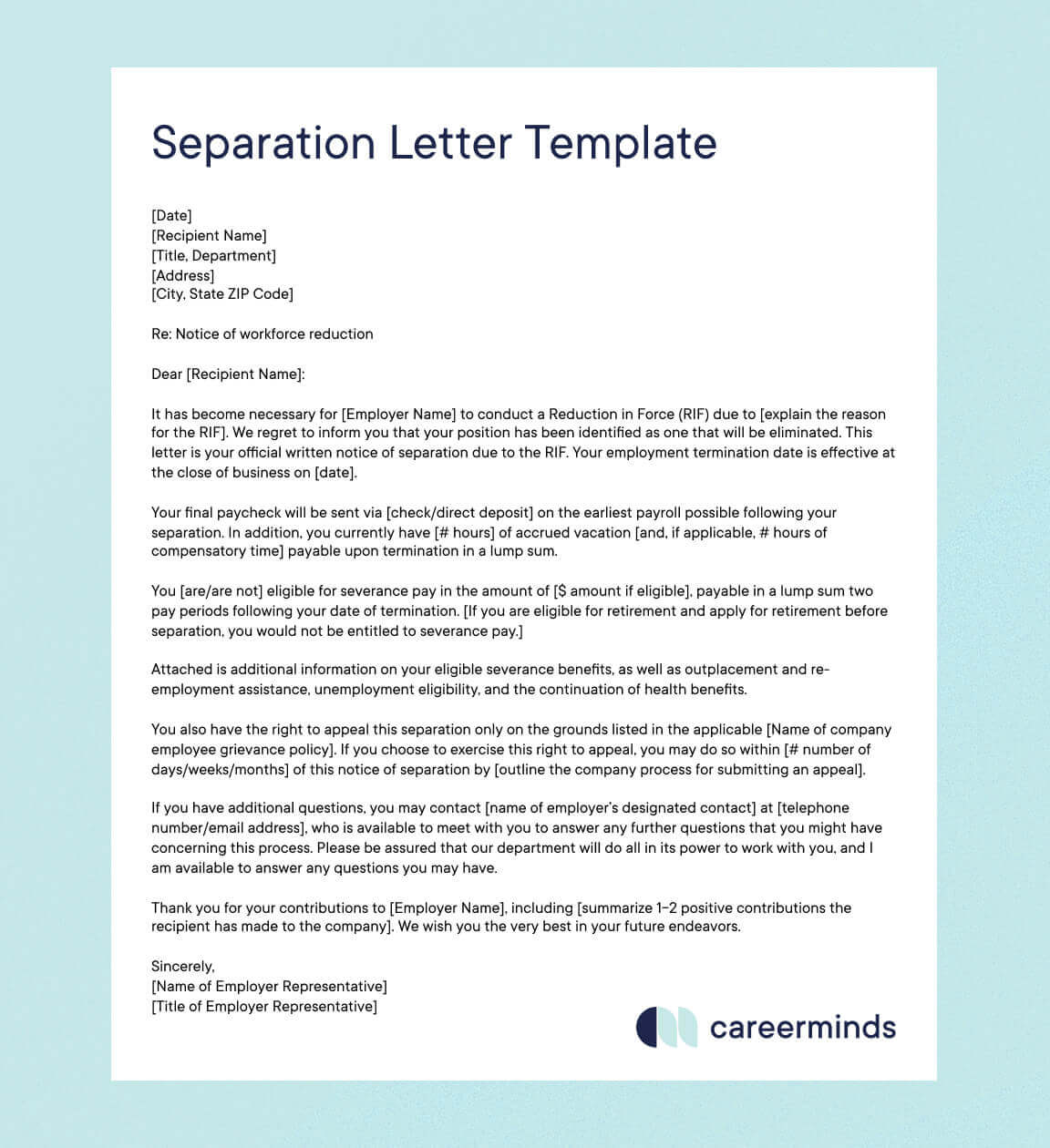
Preparing for a RIF?
Download our Essential Guide to Handling a Layoff
Request Pricing
Compare our rates to other providers
Are you preparing to conduct a reduction in force (RIF)? Perhaps your organization needs to cut costs, increase the efficiency of your current talent pool, or undergo a complete business overhaul? Whatever the reason, your RIF event will require you to prepare a formal separation notice RIF letter to notify employees about their impending termination of employment.
What Is a RIF Separation Notice?
This separation notice must be a formal letter composed thoughtfully with all of the pertinent information your impacted employees will need to know about the RIF event. Simply having management tell them to clear their desks, or send them an email informing them that there’s no need for their services anymore will not cut it.
You can’t expect employees to accept termination of employment without a timely RIF notice accompanied by a proper explanation. There are a lot of legal and moral obligations to fulfill for a termination of employment to be valid, all of which should be covered and addressed in a formal RIF notice.
But what exactly should a RIF notice include for it to be formal, respectful, and legally binding? In this article, we will cover the key points in crafting your separation notice (RIF) example to use for your next RIF event.
What Is an Example of a Separation Letter?
Let’s start with an example letter to give you an idea of what your separation notice should entail. Below is a template of a separation notice (RIF) example letter that you can copy and customize for your own RIF notification needs.
Copyable example
[Date]
[Recipient Name]
[Title, Department]
[Address]
[City, State ZIP Code]
Re: Notice of workforce reduction
Dear [Recipient Name]:
It has become necessary for [Employer Name] to conduct a Reduction in Force (RIF) due to [explain the reason for the RIF]. We regret to inform you that your position has been identified as one that will be eliminated. This letter is your official written notice of separation due to the RIF. Your employment termination date is effective at the close of business on [date].
Your final paycheck will be sent via [check/direct deposit] on the earliest payroll possible following your separation. In addition, you currently have [# hours] of accrued vacation [and, if applicable, # hours of compensatory time] payable upon termination in a lump sum.
You [are/are not] eligible for severance pay in the amount of [$ amount if eligible], payable in a lump sum two pay periods following your date of termination. [If you are eligible for retirement and apply for retirement before separation, you would not be entitled to severance pay.]
Attached is additional information on your eligible severance benefits, as well as outplacement and re-employment assistance, unemployment eligibility, and the continuation of health benefits.
You also have the right to appeal this separation only on the grounds listed in the applicable [Name of company employee grievance policy]. If you choose to exercise this right to appeal, you may do so within [# number of days/weeks/months] of this notice of separation by [outline the company process for submitting an appeal].
If you have additional questions, you may contact [name of employer’s designated contact] at [telephone number/email address], who is available to meet with you to answer any further questions that you might have concerning this process. Please be assured that our department will do all in its power to work with you, and I am available to answer any questions you may have.
Thank you for your contributions to [Employer Name], including [summarize 1-2 positive contributions the recipient has made to the company]. We wish you the very best in your future endeavors.
Sincerely,
[Name of Employer Representative]
[Title of Employer Representative]
Feel free to copy and customize this sample letter above to craft your own separation notice RIF letter. Of course, remember to consult with your legal counsel to ensure you are including all necessary language and complying with all local, state, and federal laws. You can also download our free complete guide to handling layoffs below to help get you started with what RIF letter notifications you will need.
Of course, remember that RIFs and layoffs are technically different. So make sure you learn the difference between the two to understand which reduction event you are conducting, what materials you will need, and how to prepare your staff to navigate what is happening.
How Do I Write a RIF Letter?
Now let’s break down this separation notice RIF example letter to understand its key components. Once the decision has been made to hold a reduction in force (RIF), it’s up to the HR department to prepare a formal RIF notice like the copyable example above. Although writing this RIF letter might sound easy enough, it can be the cause of many problems later on. To avoid any such problems occurring, your RIF letter should follow a specific content structure.
Here are the five key components you’ll need to include in your RIF letter:
1. Date and addressee: This information is a given, but it’s important to note who the recipient of the RIF notice is and when they have received it.
2. Reason for the RIF: Explain to the terminated employee why they have been laid off, as well as the overall timeline and from what date this RIF comes into effect.
3. Employee benefits: Outline what severance and other benefits the employee is eligible for, including outplacement support to help them accept their termination and find fulfilling new employment.
4. Employee rights: Explain what rights the impacted employee can exercise, such as the right to appeal the decision, and the process and time frame in which they may do so.
5. Positive acknowledgement: End the RIF letter on a positive note by acknowledging the employee’s contributions to the company and wishing them success in future positions.
If you fail to include any of these components in your own RIF letter, you could face security risks, retaliation, and lawsuits. So it’s best to consult with HR and legal experts who can help you create a risk-free separation notice RIF example to use as a template. Or at the very least, have someone of this expertise review your RIF letter before sending it out. This can save you a lot of headaches later on.

Don’t Forget About the WARN Act
The Worker Adjustment and Retraining Notification (WARN) Act requires employers to give 60 days written notice of the intention of terminating the employment of more than 50 employees as a result of a plant closing or mass layoff that will result in over 500 employees losing their job during any 30-day period. In these circumstances, a RIF notice must be provided to affected employees, labor unions, the local government official, and the state dislocated worker unit.
The purpose of this advance notice is to protect employees from finding themselves in a financially vulnerable position. The WARN Act ensures that employees are given sufficient time to adjust to the prospect of losing their job and seeking new employment. Organizations that fail to provide a 60 days written notice to employees will face a penalty for violating notification requirements.
However, the WARN Act notice requirements do not apply to employees who have worked for the employer for less than 6 months in the last 12 months. Neither does it apply to part-time employees who work less than 20 hours per week. Download our free WARN Act checklist to review all of its stipulations, and determine whether your RIF event will need to comply with the WARN Act regulations.
What Should I Do with the RIF Letter?
Once you have crafted and customized your separation notice RIF example letter, you will need to formally send it in writing to each employee impacted by your impending RIF event. Then the next step in your overarching RIF plan is to coordinate a RIF notification meeting with impacted employees to provide further information and answer their questions.
This means fully preparing for the meeting by familiarizing yourself with all relevant company policies and processes, arranging a convenient meeting date, time, and location with the employee, and preparing to answer any questions they have on the RIF timeline, their severance package, benefits, outplacement, and other helpful resources in as compassionate a manner as possible.
Then conducting the actual RIF notification meeting should involve clear and open communication about what is happening, the reason for the RIF event, the next steps to finalize their termination, and all of the resources available to them, all while demonstrating respectful listening, patience, and support.
Follow a RIF Meeting Script
Following a script can be a helpful way to ensure you are communicating the RIF or layoff to employees as thoroughly as possible. It might seem a bit automated at first, but using a meeting script offers some significant benefits.
For one, it helps the person conducting the RIF meeting stay on track, hit all of the necessary talking points, and avoid forgetting any other helpful details such as severance packages, outplacement services, and other various employment benefits.
Additionally, a layoff meeting script ensures that anyone conducting the RIF notification meeting will follow the same format and criteria. With a set meeting script, every person conducting a RIF meeting will know precisely what, when, why, and how every piece of information should be conveyed to impacted employees. It’s a must-have tool to set the tone, pace, and flow of every RIF notification meeting and the entire RIF process. Download our free layoff script to help guide the RIF notification meetings in your next reduction event.
Separation Notice RIF: Final Takeaways
It’s absolutely crucial that your workforce reductions are handled with care. A properly prepared RIF notice is essential for your organization in order to comply with legal regulations, maintain a positive employer brand, and ensure a smooth reduction event from start to finish.
So it is vital that you take the time to write a well-structured RIF letter that thoroughly explains the reasons for termination and all pertinent information for impacted employees. Use our separation notice RIF example above to craft your own RIF notice template for all future reduction events. Then remember to consider WARN Act notice requirements to avoid legal trouble, conduct a methodical RIF notification meeting, and follow a layoff script to ensure consistency.
When a RIF is done right, impacted employees can leave with dignity, a positive impression of their employer, and the ability to seek fulfilling new employment opportunities. Sometimes workforce reductions can be a stepping stone towards success for both employees and employers alike.
At Careerminds, we believe that you can never be too prepared for your next reduction event. Our arsenal of resources, templates, guides, and industry-leading outplacement services can help you navigate the delicate RIF process. Click below to speak with one of our experts and see if we are the right partner for your organization.
In need of outplacement assistance?
At Careerminds, we care about people first. That’s why we offer personalized talent management solutions for every level at lower costs, globally.



